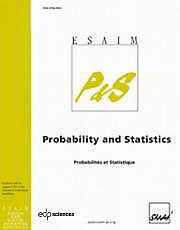Article contents
Universal Ls-rate-optimality of Lr-optimal quantizers by dilatation and contraction
Published online by Cambridge University Press: 12 June 2009
Abstract
We investigate in this paper the properties of some dilatations or contractions of a sequence (αn)n≥1 of Lr-optimal quantizers of an $\mathbb{R}^d$ -valued random vector $X \in L^r(\mathbb{P})$
-valued random vector $X \in L^r(\mathbb{P})$ defined in the probability space $(\Omega,\mathcal{A},\mathbb{P})$
defined in the probability space $(\Omega,\mathcal{A},\mathbb{P})$ with distribution $\mathbb{P}_{X} = P$
with distribution $\mathbb{P}_{X} = P$ . To be precise, we investigate the Ls-quantization rate of sequences $\alpha_n^{\theta,\mu} = \mu + \theta(\alpha_n-\mu)=\{\mu + \theta(a-\mu), \ a \in \alpha_n \}$
. To be precise, we investigate the Ls-quantization rate of sequences $\alpha_n^{\theta,\mu} = \mu + \theta(\alpha_n-\mu)=\{\mu + \theta(a-\mu), \ a \in \alpha_n \}$ when $\theta \in \mathbb{R}_{+}^{\star}, \mu \in \mathbb{R}, s \in (0,r)$
when $\theta \in \mathbb{R}_{+}^{\star}, \mu \in \mathbb{R}, s \in (0,r)$ or s ∈ (r, +∞) and $X \in L^s(\mathbb{P})$
or s ∈ (r, +∞) and $X \in L^s(\mathbb{P})$ . We show that for a wide family of distributions, one may always find parameters (θ,µ) such that (αnθ,µ)n≥1 is Ls-rate-optimal. For the Gaussian and the exponential distributions we show the existence of a couple (θ*,µ*) such that (αθ*,µ*)n≥1 also satisfies the so-called Ls-empirical measure theorem. Our conjecture, confirmed by numerical experiments, is that such sequences are asymptotically Ls-optimal. In both cases the sequence (αθ*,µ*)n≥1 is incredibly close to Ls-optimality. However we show (see Rem. 5.4) that this last sequence is not Ls-optimal (e.g. when s = 2, r = 1) for the exponential distribution.
. We show that for a wide family of distributions, one may always find parameters (θ,µ) such that (αnθ,µ)n≥1 is Ls-rate-optimal. For the Gaussian and the exponential distributions we show the existence of a couple (θ*,µ*) such that (αθ*,µ*)n≥1 also satisfies the so-called Ls-empirical measure theorem. Our conjecture, confirmed by numerical experiments, is that such sequences are asymptotically Ls-optimal. In both cases the sequence (αθ*,µ*)n≥1 is incredibly close to Ls-optimality. However we show (see Rem. 5.4) that this last sequence is not Ls-optimal (e.g. when s = 2, r = 1) for the exponential distribution.
- Type
- Research Article
- Information
- Copyright
- © EDP Sciences, SMAI, 2009
References
- 1
- Cited by




